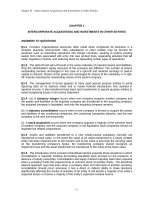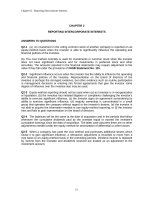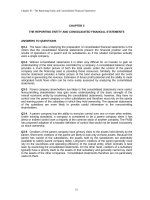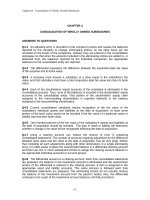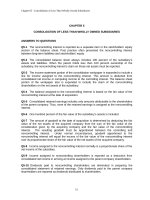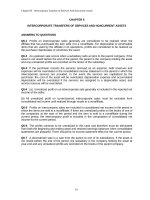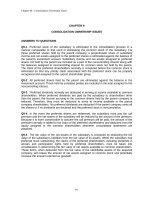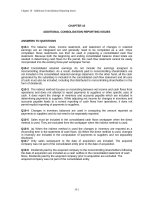Solution manual advanced financial accounting, 8th edition by baker chap008
Bạn đang xem bản rút gọn của tài liệu. Xem và tải ngay bản đầy đủ của tài liệu tại đây (250.78 KB, 63 trang )
Chapter 08 - Intercompany Indebtedness
CHAPTER 8
INTERCOMPANY INDEBTEDNESS
ANSWERS TO QUESTIONS
Q8-1 A gain or loss on bond retirement is reported by the consolidated entity whenever (a)
one of the companies purchases its own bonds from a nonaffiliate at an amount other than
book value, or (b) a company within the consolidated entity purchases the bonds of an
affiliate from a nonaffiliate at an amount other than book value.
Q8-2 A constructive retirement occurs when the bonds of a company included in the
consolidated entity are purchased by another company included within the consolidated
entity. Although the debtor still considers the bonds as outstanding, and the investor views
the bonds as an investment, they are constructively retired for consolidation purposes. If
bonds are actually retired, the debtor purchases its own bonds from a nonaffiliate and they
are no longer outstanding.
Q8-3 When bonds sold to an affiliate at par value are not eliminated, bonds payable and
bond investment are misstated in the balance sheet accounts and interest income and
interest expense are misstated in the income statement accounts. There is also a premium or
discount account to be eliminated when the bonds are not issued at par value. Unless
interest is paid at year-end, there is likely to be some amount of interest receivable and
interest payable to be eliminated as well.
Q8-4 Both the bond investment and interest income reported by the purchaser will be
improperly included. Interest expense, bonds payable, and any premium or discount
recorded on the books of the debtor also will be improperly included. In addition, the
constructive gain or loss on bond retirement will be omitted if no eliminating entries are
recorded in connection with the purchase.
Q8-5 If the focus is placed on the legal entity, only bonds actually reacquired by the debtor
will be treated as retired. This treatment can lead to incorrect reports for the consolidated
entity in two dimensions. If a company were to repurchase bonds from an affiliate, any
retirement gain or loss reported by the debtor is not a gain or loss to the economic entity and
must be eliminated in preparing consolidated statements. Moreover, although a purchase of
debt of any of the other companies in the consolidated entity will not be recognized as a
retirement by the debtor, when emphasis is placed on the economic entity the purchase must
serve as a basis for recognition of a bond retirement for the consolidated entity.
Q8-6 The difference in treatment is due to the effect of the transactions on the consolidated
entity. In the case of land sold to another affiliate, a gain has been recorded that is not a gain
from the viewpoint of the consolidated entity. Thus, it must be eliminated in the consolidation
process. On the other hand, in a bond repurchase the buyer simply records an investment in
bonds and the debtor makes no special entries because of the purchase by an affiliate.
Neither company records the effect of the transaction on the economic entity. Thus, in the
consolidation process an entry must be made to show the gain on bond retirement that has
occurred from the viewpoint of the economic entity.
8-1
Chapter 08 - Intercompany Indebtedness
Q8-7 When there has been a direct sale to an affiliate, the interest income recorded by the
purchaser should equal the interest expense recorded by the seller and the two items should
have no net effect on reported income. The eliminating entries do not change consolidated
net income in this case, but they will result in a more appropriate statement of the relevant
income and expense categories in the consolidated income statement.
Q8-8 Whenever a loss on bond retirement has been reported in a prior period, the affiliate
that purchased the bonds paid more than the book value of the debt shown by the debtor. As
a result, each period the interest income recorded by the buyer will be less than the interest
expense reported by the debtor. When the two income statement accounts are eliminated in
the consolidation process, the effect will be to increase consolidated net income. Because
the full amount of the loss was recognized for consolidated purposes in the year in which the
bonds were purchased by the affiliate, the effect of the elimination process in each of the
periods that follow should be to increase consolidated income.
Q8-9 The difference between the carrying value of the debt on the debtor's books and the
carrying value of the investment on the purchaser's books indicates the amount of
unrecognized gain or loss at the end of the period. To determine the amount of the gain or
loss on retirement at the start of the period, the difference between interest income recorded
by the purchaser on the bond that has been purchased and interest expense recorded by the
debtor during the period is added to the difference between carrying values at the end of the
period.
Q8-10 Interest income and interest expense must be eliminated and a loss on bond
retirement established in the elimination process. Consolidated net income will decrease by
the amount of the loss. Because the loss is attributed to the subsidiary, income assigned to
the controlling and noncontrolling interests will decrease in proportion to their share of
common stock held.
Q8-11 A constructive gain will be included in the consolidated income statement in this case
and both consolidated net income and income to the controlling interest will increase by the
full amount of the gain.
Q8-12 A direct placement of subsidiary bonds with the parent should have no effect on
consolidated income or on income assigned to the noncontrolling shareholders.
Q8-13 When subsidiary bonds are purchased from a nonaffiliate by the parent and there is a
constructive gain or loss for consolidated purposes, the gain or loss is assigned to the
subsidiary and included in computing income to the noncontrolling shareholders.
Q8-14 Interest income recorded by the subsidiary and interest expense recorded by the
parent should be equal in the direct placement case. When the subsidiary purchases parent
company bonds from a nonaffiliate, interest income and interest expense will not be the
same unless the bonds are purchased from the nonaffiliate at an amount equal to the liability
reported by the parent.
8-2
Chapter 08 - Intercompany Indebtedness
Q8-15 A gain on constructive bond retirement recorded in a prior period means the bonds
were purchased for less than book value and the interest income recorded by the subsidiary
each period will be greater than the interest expense recorded by the parent. Consolidated
net income for the current period will decrease by the difference between interest income and
interest expense as these amounts are eliminated in preparing the consolidated statements.
Income to the noncontrolling interest will be unaffected since the constructive gain is
assigned to parent company.
Q8-16 A constructive loss recorded on the subsidiary's bonds in a prior period means the
interest income recorded by the parent is less than the interest expense recorded by the
subsidiary in each of the following periods. Consolidated net income will increase when
interest income and expense are eliminated. Income assigned to the noncontrolling interest
will be based on the reported net income of the subsidiary plus the difference between
interest income and interest expense each period following the retirement. As a result, the
amount assigned will be greater than if the bond had not been constructively retired.
Q8-17 On the date the parent sells the bonds to a nonaffiliate they are issued for the first
time from a consolidated perspective. While the parent will record a gain or loss on sale of
the bonds on its books, none is recognized from a consolidated viewpoint. The difference
between the sale price received by the parent and par value is a premium or discount. Each
period there will be a need to establish the correct amount for the premium or discount
account and to adjust interest expense recorded by the subsidiary to bring the reported
amounts into conformity with the sale price to the nonaffiliate.
Q8-18 The retirement gain or loss reported by the subsidiary when it repurchases the bonds
held by the parent must be eliminated in the consolidation process. From the viewpoint of the
consolidated entity the bonds were retired at the point they were purchased by the parent
and a gain or loss should have been recognized at that point.
8-3
Chapter 08 - Intercompany Indebtedness
SOLUTIONS TO CASES
C8-1 Recognition of Retirement Gains and Losses
a. When Flood purchases the bonds it establishes an investment account on its books and
Bradley establishes a bond liability and discount account on its books. No entry is made by
Century. When Century purchases the bonds, Century records an investment and Flood
removes the balance in the investment account and records a gain on the sale. Bradley
makes no entry. When Bradley retires the issue, Bradley removes its liability and
unamortized discount and records a loss on bond retirement. Century removes the bond
investment account and records a loss on the sale of bonds. Flood makes no entry.
b. A constructive loss on bond retirement is reported by the consolidated entity at the time
Century purchases the bonds from Flood. The exact amount of the loss cannot be
ascertained without knowing the maturity date of the bonds, the date of initial sale, and the
date of purchase by Century.
c. The initial sale of bonds by Bradley is treated as a normal transaction with no need for an
adjustment to income assigned to the noncontrolling shareholders. Income assigned to
noncontrolling shareholders will be reduced by a proportionate share of the loss reported in
the consolidated income statement in the period in which Century purchases the bonds from
Flood. In the years before the bonds are retired by Bradley, income assigned to the
noncontrolling interest (assuming no differential) will be greater than a pro rata portion of the
reported net income of Bradley. In the period in which the bonds are retired by Bradley,
reported net income of Bradley must be adjusted to remove its loss on bond retirement
before assigning income to the noncontrolling interest. No adjustment is made in the years
following the repurchase by Bradley.
8-4
Chapter 08 - Intercompany Indebtedness
C8-2 Borrowing by Variable Interest Entities
MEMO
To:
President
Hydro Corporation
From:
Re:
, Accounting Staff
Consolidation of Joint Venture
Hydro Corporation and Rich Corner Bank established a joint venture which borrowed
$30,000,000 and built a new production facility. That facility is now leased to Hydro on a 10year operating lease. Hydro currently reports the annual lease payment as an operating
expense and in the notes to its financial statements must report a contingent liability for its
guarantee of the debt of the joint venture. I have been asked to review the current financial
reporting standards and determine whether Hydro’s current reporting is appropriate.
The circumstances surrounding the creation of the joint venture and the lease arrangement
with Hydro appear to point to the need for Hydro to consolidate the joint venture with its own
operations. Although Rich Corner Bank holds 100 percent of the equity of the joint venture, it
has contributed less than 1 percent of the total assets of the joint venture ($200,000 of equity
versus $30,000,000 of total borrowings). Under normal circumstances, less than a 10
percent investment in the entity’s total assets is considered insufficient to permit the entity to
finance its activities. [FASB INT. 46, Par 9]
In this situation, Hydro has guaranteed the $30,000,000 borrowed by the joint venture and
has guaranteed a 20 percent annual return on the equity investment of Rich Corner Bank.
These conditions will result in Hydro Corporation absorbing any losses incurred by the joint
venture and establish Hydro Corporation as the primary beneficiary of the entity. The FASB
requires consolidation by the entity that will absorb a majority of the entity’s expected losses
if they occur. [FASB INT. 46, Par. 14]
Consolidation of the joint venture will result in including the production facility among Hydro’s
assets and the debt as part of its long-term liabilities. The claim on the net assets of the joint
venture held by Rich Corner Bank will be reported as part of noncontrolling interest. Hydro’s
consolidated income statement will not include the lease payment as an operating expense,
but will include depreciation expense on the production facility and interest expense for the
interest payment made on the borrowing of the joint venture.
Primary citation:
FASB INT. 46
8-5
Chapter 08 - Intercompany Indebtedness
Case 8-3 Subsidiary Bond Holdings
MEMO
To:
Financial Vice-President
Farflung Corporation
From:
Re:
, Accounting Staff
Investment in Bonds Issued by Subsidiary
The consolidated financial statements of Farflung Corporation should include both Micro
Company and Eagle Corporation. The purpose of the consolidated statements is to present
the financial position and results of operations for a parent and one or more subsidiaries as if
the individual entities actually were a single company or entity. [ARB 51, Par. 1]
When one subsidiary purchases the bonds of another, the investment reported by the
purchasing affiliate and the liability reported by the debtor must be eliminated and a gain or
loss reported on the difference between the purchase price and the carrying value of the debt
at the time of purchase.
In preparing Farflung’s consolidated statements at December 31, 20X4, the following
eliminating entry should have been included in the workpaper:
E(1) Bonds Payable
Loss on Bond Retirement
Investment in Micro Company Bonds
400,000
24,000
424,000
The $24,000 loss should have been included in the consolidated income statement, leading
to a reduction of $15,600 ($24,000 x .65) in income assigned to the controlling interest and a
reduction of $8,400 ($24,000 x .35) in income assigned to noncontrolling shareholders. This
error should be corrected by restating the financial statements of the consolidated entity for
20X4.
While omission of the eliminating entry resulted in incorrect financial statements for the
consolidated entity, it should have no impact on the financial statements of the individual
subsidiaries. Assuming (1) the bonds had 15 years remaining until maturity when purchased
by Eagle and pay 8 percent interest annually, (2) straight-line amortization of the premium
paid by Eagle is appropriate, and (3) the consolidated financial statements as of December
31, 20X4, are corrected, the eliminating entry at December 31, 20X5, is:
8-6
Chapter 08 - Intercompany Indebtedness
C8-3 (continued)
E(2)
Bonds Payable
Interest Income
Retained Earnings
Noncontrolling Interest
Investment in Micro Company Bonds
Interest Expense
400,000
30,400(a)
15,600
8,400
422,400(b)
32,000(c)
(a) ($400,000 x .08) - ($24,000/15 years)
(b) $424,000 - ($24,000/15 years)
(c) $400,000 x .08
Primary citation:
ARB 51, Par. 6
C8-4 Interest Income and Expense
a. Snerd apparently paid more than par value for the bonds and is amortizing the premium
against interest income over the life of the bonds. Thus, the cash received is greater than the
amount of interest income recorded.
b.
With the information given, the following appears to be true:
(1) When purchasing the bonds, Snerd apparently paid less than the current carrying
amount of the bonds on the subsidiary’s books because a constructive gain on bond
retirement is included in the 20X3 consolidated income statement. Since Snerd paid par
value for the bonds, they must have been sold at a premium by the subsidiary.
(2) Because the bonds were sold at a premium, interest expense recorded by the
subsidiary will be less than the annual interest payment made to the parent.
(3) Interest income recorded each period by Snerd will exceed interest expense
recorded by the subsidiary. When the two balances are eliminated, the effect will be to
reduce income to both the controlling and noncontrolling shareholders.
8-7
Chapter 08 - Intercompany Indebtedness
C8-5 Intercompany Debt
Answers to this case can be found in the SEC Form 10-K filed by Hershey Foods and its
annual report.
a. When intercompany loans are made between affiliates in different countries, the problem
of changing currency exchange rates may arise, especially if any of the loans are
denominated in a currency that rapidly changes in value against the dollar. Hershey Foods
and many other companies in the same situation hedge their intercompany
receivables/payables through foreign currency forward contracts and swaps.
b. Hershey's intercompany receivables/payables
intercompany purchases and sales of goods.
8-8
appear
to
come
primarily
from
Chapter 08 - Intercompany Indebtedness
SOLUTIONS TO EXERCISES
E8-1 Bond Sale from Parent to Subsidiary
a.
Journal entries recorded by Humbolt Corporation:
January 1, 20X2
Investment in Lamar Corporation Bonds
Cash
July 1, 20X2
Cash
Interest Income
Investment in Lamar Corporation Bonds
156,000
4,500
156,000
4,200
300
December 31, 20X2
Interest Receivable
Interest Income
Investment in Lamar Corporation Bonds
b.
4,500
Journal entries recorded by Lamar Corporation:
January 1, 20X2
Cash
Bonds Payable
Bond Premium
156,000
July 1, 20X2
Interest Expense
Bond Premium
Cash
4,200
300
December 31, 20X2
Interest Expense
Bond Premium
Interest Payable
4,200
300
c.
4,200
300
150,000
6,000
4,500
4,500
Eliminating entries, December 31, 20X2:
E(1)
E(2)
Bonds payable
Premium on Bonds Payable
Interest income
Investment in Lamar Corporation Bonds
Interest expense
Eliminate intercorporate bond holdings.
Interest payable
Interest receivable
Eliminate intercompany receivable/payable.
8-9
150,000
5,400
8,400
4,500
155,400
8,400
4,500
Chapter 08 - Intercompany Indebtedness
E8-2 Computation of Transfer Price
a.
$105,000 = $100,000 par value + ($250 x 20 periods) premium
b.
$103,500 = $105,000 - ($250 x 6 periods)
c.
Eliminating entries:
E(1)
E(2)
Bonds Payable
Bond Premium
Interest Income
Investment in Nettle Corporation Bonds
Interest Expense
Interest Payable
Interest Receivable
100,000
3,500
11,500
6,000
103,500
11,500
6,000
E8-3 Bond Sale at Discount
a.
$16,800 = [($600,000 x .08) + ($12,000 / 5 years)] x 1/3
b.
Journal entries recorded by Wood Corporation:
January 1, 20X4
Cash
Interest Receivable
16,000
July 1, 20X4
Cash
Investment in Carter Company Bonds
Interest Income
$800 = ($400,000 - $392,000)/(5 x 2)
December 31, 20X4
Interest Receivable
Investment in Carter Company Bonds
Interest Income
c.
16,000
800
16,000
800
16,000
16,800
16,800
Eliminating entries, December 31, 20X4:
E(1)
E(2)
Bonds Payable
Interest Income
Investment in Carter Company Bonds
Bond Discount
Interest Expense
$33,600 = $16,000 + $16,000 + $800 + $800
$395,200 = $392,000 + ($800 x 4)
$4,800 = $8,000 - ($800 x 4)
Interest Payable
Interest Receivable
400,000
33,600
16,000
8-10
395,200
4,800
33,600
16,000
Chapter 08 - Intercompany Indebtedness
E8-4 Evaluation of Intercorporate Bond Holdings
a.
The bonds were originally sold at a discount. Stellar purchased the bonds at par value
and a constructive loss was reported.
b.
The annual interest payment received by Stellar will be less than the interest expense
recorded by the subsidiary. When bonds are sold at a discount, the issue price of the
bonds is adjusted downward because the annual interest payment is less than is
needed to issue the bonds at par value.
c.
In 20X6, consolidated net income was decreased as a result of the loss on constructive
retirement of bonds. Each period following the purchase, the amount of interest expense
recorded by the subsidiary will exceed the interest income recorded by the parent.
When these two amounts are eliminated, consolidated net income will be increased.
Thus, consolidated net income for 20X7 will be increased.
E8-5 Multiple-Choice Questions
1.
a
A constructive gain of $100,000 is included in consolidated net income for the period
ended March 31, 20X8, and consolidated retained earnings at March 31, 20X8.
Because the bonds of the parent are constructively retired, there is no effect on the
amounts assigned to the noncontrolling interest. [AICPA Adapted]
2.
a
The loss on bond retirement will result in a reduction in consolidated retained
earnings. [AICPA Adapted]
3.
b $4,700 = ($50,000 x .10) - ($3,000 / 10 years)
4.
a $4,000 = ($50,000 x .10) - ($8,000 / 8 years)
5.
c
$5,600 loss = $58,000 purchase price
- [$53,000 - ($3,000 / 10 years) x 2 years]
6.
c
Operating income of Kruse Corporation
Net income of Gary's Ice Cream Parlors
Less:
Loss on bond retirement
Recognition during 20X6
($4,700 - $4,000)
Consolidated net income
$40,000
20,000
$60,000
(5,600)
700
$55,100
8-11
Chapter 08 - Intercompany Indebtedness
E8-6 Multiple-Choice Questions
1.
a
$14,000 = [($300,000 x .09) - ($60,000 / 10 years)]
x ($200,000 / $300,000)
2.
c
$12,000 = [$120,000 - ($20,000 / 10 years) x 2 years] - $104,000
3.
b
Net income of Solar Corporation
Unrecognized portion of gain
on bond retirement ($12,000 - $1,500)
Proportion of stock held by
noncontrolling interest
Income to noncontrolling interest
$30,000
10,500
$40,500
x
.20
$ 8,100
E8-7 Constructive Retirement at End of Year
a.
Eliminating entries, December 31, 20X5:
E(1)
E(2)
b.
Bonds Payable
Premium on Bonds Payable
Investment in Able Company Bonds
Gain on Bond Retirement
$9,000 = [($400,000 x 1.03) - $400,000] x 15/20
$12,000 = $9,000 + $400,000 - $397,000
Interest Payable
Interest Receivable
400,000
9,000
18,000
397,000
12,000
18,000
Eliminating entries, December 31, 20X6:
E(1)
E(2)
Bonds Payable
Premium on Bonds Payable
Interest Income
Investment in Able Company Bonds
Interest Expense
Retained Earnings, January 1
Noncontrolling Interests
$8,400 = $9,000 - [$9,000 / (15 x 2)] x 2
$36,200 = $36,000 + [$3,000 / (15 x 2)] x 2
$397,200 = $397,000 + ($100 x 2)
$35,400 = $36,000 - ($300 x 2)
$7,200 = $12,000 x .60
$4,800 = $12,000 x .40
Interest Payable
Interest Receivable
400,000
8,400
36,200
18,000
8-12
397,200
35,400
7,200
4,800
18,000
Chapter 08 - Intercompany Indebtedness
E8-8 Constructive Retirement at Beginning of Year
a.
Eliminating entries, December 31, 20X5:
E(1)
E(2)
b.
Bonds Payable
Premium on Bonds Payable
Interest Income
Investment in Able Company Bonds
Interest Expense
Gain on Bond Retirement
$9,000 = [($400,000 x 1.03) - $400,000] x 15/20
$36,200 = $36,000 +
[($400,000 - $396,800)/(16 x 2)] x 2
$397,000 = $396,800 + ($100 x 2)
$35,400 = $36,000 - ($300 x 2)
$12,800 = [($400,000 x 1.03) - $400,000]
x 16/20 + ($400,000 - $396,800)
Interest Payable
Interest Receivable
400,000
9,000
36,200
18,000
397,000
35,400
12,800
18,000
Eliminating entries, December 31, 20X6:
E(1)
E(2)
Bonds Payable
Premium on Bonds Payable
Interest Income
Investment in Able Company Bonds
Interest Expense
Retained Earnings, January 1
Noncontrolling Interests
Interest Payable
Interest Receivable
400,000
8,400
36,200
18,000
8-13
397,200
35,400
7,200
4,800
18,000
Chapter 08 - Intercompany Indebtedness
E8-9 Retirement of Bonds Sold at a Discount
Elimination of bond investment at December 31, 20X8:
Bonds Payable
300,000
Interest Income
21,240
Loss on Constructive Bond Retirement
2,730
Investment in Farley Corporation Bonds
Interest Expense
Discount on Bonds Payable
Eliminate intercorporate bond holdings:
$21,240 = $21,000 + [($300,000 - $296,880) / 13 years]
$2,730 = $296,880 - $294,150 (computed below)
$297,120 = $296,880 + [($300,000 - $296,880) / 13 years]
$21,450 = $21,000 + ($9,000 / 20 years)
$5,400 = ($9,000 / 20 years) x 12 years
297,120
21,450
5,400
Computation of book value of liability at constructive retirement
Sale price of bonds ($300,000 x .97)
Amortization of discount
[($300,000 - $291,0000) / 20 years] x 7 years
Book value of liability at January 1, 20X8
$291,000
3,150
$294,150
E8-10 Loss on Constructive Retirement
Eliminating entries, December 31, 20X8:
E(1)
E(2)
Bonds Payable
Interest Income
Loss on Bond Retirement
Investment in Apple Corporation Bonds
Discount on Bonds Payable
Interest Expense
Interest Payable
Interest Receivable
100,000
8,000
12,000
5,000
8-14
106,000
3,000
11,000
5,000
Chapter 08 - Intercompany Indebtedness
E8-11 Determining the Amount of Retirement Gain or Loss
a.
Par value of bonds outstanding
Annual interest rate
Interest payment
Amortization of bond premium
($15,000 x 2 bonds) / 5 years
Interest charge for full year
Less: Interest on bond purchased by Online Enterprises
[($18,000 x 1/2) x (4 months / 12 months)]
Interest expense included in consolidated
income statement
$200,000
x
.12
$ 24,000
b.
Sale price of bonds, January 1, 20X1
Amortization of premium [($15,000 / 5) x 2 2/3 years]
Book value at time of purchase
Purchase price
Gain on bond retirement
$115,000
(8,000)
$107,000
(100,000)
$ 7,000
c.
Eliminating entries, December 31, 20X3:
E(1)
E(2)
Bonds Payable
Bond Premium
Interest Income
Investment in Downlink Bonds
Interest Expense
Gain on Bond Retirement
(6,000)
$ 18,000
(3,000)
$ 15,000
100,000
6,000
4,000
Interest Payable
Interest Receivable
6,000
8-15
100,000
3,000
7,000
6,000
Chapter 08 - Intercompany Indebtedness
E8-12 Evaluation of Bond Retirement
a.
No gain or loss will be reported by Bundle.
b.
A gain of $13,000 will be reported:
Book value of liability reported by Bundle:
Par value of bonds outstanding
Unamortized premium
$8,000 - [($8,000 / 10 years) x 3.5 years]
Book value of debt
Amount paid by Parent
Gain on bond retirement
c.
5,200
$205,200
(192,200)
$ 13,000
Consolidated net income for 20X6 will increase by $12,000:
Gain on bond retirement
Adjustment for excess of interest income
over interest expense:
Interest income
Interest expense
Increase in consolidated net income
d.
$200,000
$ 13,000
$(11,600)
10,600
(1,000)
$ 12,000
Eliminating entries, December 31, 20X6:
E(1)
E(2)
Bonds Payable
Premium on Bonds Payable
Interest Income
Investment in Bundle Company Bonds
Interest Expense
Gain on Bond Retirement
Eliminate intercorporate bond holdings:
$4,800 = ($8,000 / 10 years) x 6 years
$11,600 = [$22,000 + ($7,800 / 6.5 years)] / 2
$192,800 = $192,200 + [($7,800 / 6.5 years) / 2]
$10,600 = ($22,000 - $800) / 2
Interest Payable
Interest Receivable
Eliminate intercompany receivable/payable.
8-16
200,000
4,800
11,600
11,000
192,800
10,600
13,000
11,000
Chapter 08 - Intercompany Indebtedness
E8-12 (continued)
e.
Eliminating entries, December 31, 20X7:
E(1)
E(2)
f.
Bonds Payable
Premium on Bonds Payable
Interest Income
Investment in Bundle Company Bonds
Interest Expense
Retained Earnings, January 1
Noncontrolling Interest
Eliminate intercorporate bond holdings:
$4,000 = ($8,000 / 10 years) x 5 years
$23,200 = $22,000 + ($7,800 / 6.5 years)
$194,000 = $192,800 + ($7,800 / 6.5 years)
$21,200 = $22,000 - ($8,000 / 10 years)
$8,400 = ($13,000 - $1,000) x .70
$3,600 = ($13,000 - $1,000) x .30
200,000
4,000
23,200
Interest Payable
Interest Receivable
Eliminate intercompany receivable/payable.
11,000
194,000
21,200
8,400
3,600
11,000
Income assigned to noncontrolling interest in 20X7 is $14,400:
Net income reported by Bundle
Adjustment for excess of interest income
over interest expense:
Interest income
Interest expense
Realized net income
Proportion of ownership held
Income assigned to noncontrolling interest
$ 50,000
$(23,200)
21,200
8-17
(2,000)
$ 48,000
x
.30
$ 14,400
Chapter 08 - Intercompany Indebtedness
E8-13 Elimination of Intercorporate Bond Holdings
a.
Eliminating entries, December 31, 20X8:
E(1)
E(2)
b.
Bonds Payable
Premium on Bonds Payable
Interest Income
Constructive Loss on Bond Retirement
Investment in Stang Corporation Bonds
Interest Expense
Eliminate intercorporate bond holdings:
$3,000 = $5,000 - ($500 x 4 years)
$11,300 = $12,000 - ($4,900 / 7 years)
$1,400 = $104,900 - ($105,000 - $1,500)
$104,200 = $104,900 - ($4,900 / 7 years)
$11,500 = $12,000 - ($5,000 / 10 years)
Interest Payable
Interest Receivable
Eliminate intercompany receivable/payable.
6,000
104,200
11,500
6,000
Income assigned to noncontrolling interest in 20X8 is $6,580:
Net income reported by Stang Corporation
Constructive loss on bond retirement
Adjustment for excess of interest expense
over interest income:
Interest expense
Interest income
Realized net income
Proportion of ownership held
Income assigned to noncontrolling interest
c.
100,000
3,000
11,300
1,400
$ 20,000
(1,400)
$11,500
(11,300)
200
$ 18,800
x
.35
$ 6,580
Eliminating entries, December 31, 20X9:
E(1)
E(2)
Bonds Payable
Premium on Bonds Payable
Interest Income
Retained Earnings, January 1
Noncontrolling Interest
Investment in Stang Corporation Bonds
Interest Expense
Eliminate intercorporate bond holdings:
$2,500 = $3,000 - $500
$11,300 = $12,000 - ($4,900 / 7 years)
$780 = ($1,400 - $200) x .65
$420 = ($1,400 - $200) x .35
$103,500 = $104,200 - $700
$11,500 = $12,000 - ($5,000 / 10 years)
Interest Payable
Interest Receivable
Eliminate intercompany receivable/payable.
8-18
100,000
2,500
11,300
780
420
6,000
103,500
11,500
6,000
Chapter 08 - Intercompany Indebtedness
SOLUTIONS TO PROBLEMS
P8-14 Consolidation Workpaper with Sale of Bonds to Subsidiary
a.
Entries recorded by Porter on its investment in Temple:
Cash
Investment in Temple Corporation Stock
Record dividends from Temple:
$10,000 x .60
Investment in Temple Corporation Stock
Income from Subsidiary
Record equity-method income:
$30,000 x .60
b.
18,000
6,000
18,000
Entry recorded by Porter on its bonds payable:
Interest Expense
Bond Premium
Cash
Record interest payment:
$400 = ($82,000 - $80,000) / 5 years
c.
6,000
6,000
400
6,400
Entry recorded by Temple on bond investment:
Cash
Interest Income
Investment in Porter Company Bonds
8-19
6,400
6,000
400
Chapter 08 - Intercompany Indebtedness
P8-14 (continued)
d.
Eliminating entries, December 31, 20X2:
E(1)
Income from Subsidiary
Dividends Declared
Investment in Temple Corporation Stock
Eliminate income from subsidiary.
18,000
E(2)
Income to Noncontrolling Interest
Dividends Declared
Noncontrolling Interest
Assign income to noncontrolling interest:
$12,000 = $30,000 x .40
12,000
E(3)
Common Stock — Temple Corporation
Retained Earnings, January 1
Investment in Temple Corporation Stock
Noncontrolling Interest
Eliminate beginning investment balance:
$90,000 = $102,000 - $12,000
$60,000 = ($100,000 + $50,000) x .40
E(4)
Bonds payable
Premium on Bonds Payable
Interest income
Investment in Porter Company Bonds
Interest expense
Eliminate intercorporate bond holdings:
$1,200 = ($82,000 - $80,000) x 3/5
$81,200 = ($82,000 - $800)
8-20
100,000
50,000
80,000
1,200
6,000
6,000
12,000
4,000
8,000
90,000
60,000
81,200
6,000
Chapter 08 - Intercompany Indebtedness
P8-14 (continued)
e.
Porter Company and Temple Corporation
Consolidation Workpaper
December 31, 20X2
Item
Sales
Interest Income
Income from Subsidiary
Credits
Cost of Goods Sold
Depreciation Expense
Interest Expense
Debits
Consolidated Net Income
Income to Noncontrolling Interest
Income, carry forward
Porter
Co.
200,000
Temple
Corp.
114,000
6,000
18,000
218,000
99,800
25,000
6,000
(130,800)
120,000
61,000
15,000
14,000
(90,000)
87,200
30,000
Dividends Declared
230,000
87,200
317,200
(40,000)
Retained Earnings, Dec. 31,
carry forward
Retained Earnings, Jan. 1
Income, from above
Cash and Accounts
Receivable
Inventory
Buildings and Equipment
Investment in Temple
Corporation Stock
Investment in Porter
Company Bonds
Debits
Eliminations
Debit
Credit
(4) 6,000
(1) 18,000
(4) 6,000
(2) 12,000
36,000
6,000
50,000
30,000
80,000
(10,000)
(3) 50,000
36,000
6,000
277,200
70,000
86,000
80,200
120,000
500,000
40,000
65,000
300,000
(1) 6,000
(2) 4,000
Accum. Depreciation
Accounts Payable
Bonds Payable
Bond Premium
Common Stock
Porter Company
Temple Corporation
Retained Earnings,
from above
Noncontrolling
Interest
175,000
68,800
80,000
1,200
Credits
802,200
200,000
277,200
314,000
160,800
40,000
14,000
(214,800)
99,200
(12,000)
87,200
230,000
87,200
317,200
(40,000)
277,200
120,200
185,000
800,000
102,000
802,200
16,000
Consolidated
314,000
(1) 12,000
(3) 90,000
81,200
486,200
75,000
41,200
200,000
(4) 81,200
1,105,200
250,000
110,000
200,000
(4) 80,000
(4) 1,200
200,000
100,000
(3)100,000
70,000
86,000
16,000
277,200
267,200
(2) 8,000
(3) 60 000
267,200
68,000
1,105,200
486,200
8-21
Chapter 08 - Intercompany Indebtedness
P8-15 Consolidation Workpaper with Sale of Bonds to Parent
a.
b.
Entries recorded by Mega Corporation on its investment in Tarp Company:
Cash
Investment in Tarp Company Stock
Record dividends from Temple:
$20,000 x .90
18,000
Investment in Tarp Company Stock
Income from Subsidiary
Record equity-method income:
$25,000 x .90
22,500
22,500
Entry recorded by Mega Corporation on its investment in Tarp Company bonds:
Cash
Interest Income
Investment in Tarp Company Bonds
Record interest payment:
$800 = ($104,000 - $100,000) / 5 years
c.
18,000
6,000
5,200
800
Entry recorded by Tarp Company on its bonds payable:
Interest Expense
Bond Premium
Cash
5,200
800
8-22
6,000
Chapter 08 - Intercompany Indebtedness
P8-15 (continued)
d.
Eliminating entries, December 31, 20X4:
E(1)
Income from Subsidiary
Dividends Declared
Investment in Tarp Company Stock
Eliminate income from subsidiary.
E(2)
Income to Noncontrolling Interest
Dividends Declared
Noncontrolling Interest
Assign income to noncontrolling interest:
$2,500 = $25,000 x .10
2,500
E(3)
Common Stock — Tarp Company
Retained Earnings, January 1
Investment in Tarp Company Stock
Noncontrolling Interest
Eliminate beginning investment balance:
$117,000 = $121,500 - $4,500
$13,000 = ($80,000 + $50,000) x .10
80,000
50,000
Bonds Payable
Premium on Bonds Payable
Interest Income
Investment in Tarp Company Bonds
Interest Expense
Eliminate intercorporate bond holdings:
$1,600 = $4,000 x 2/5
$101,600 = $104,000 - ($4,000 x 3/5)
100,000
1,600
5,200
E(4)
8-23
22,500
18,000
4,500
2,000
500
117,000
13,000
101,600
5,200
Chapter 08 - Intercompany Indebtedness
P8-15 (continued)
Mega Corporation and Tarp Company
Consolidation Workpaper
December 31, 20X4
e.
Item
Sales
Interest Income
Income from Subsidiary
Credits
Cost of Goods Sold
Depreciation Expense
Interest Expense
Debits
Consolidated Net Income
Income to Noncontrolling Interest
Income, carry forward
Mega
Tarp
Corp.
Co.
140,000
125,000
5,200
22,500
167,700
125,000
86,000
79,800
20,000
15,000
16,000
5,200
(122,000) (100,000)
(3) 50,000
30,200
5,200
257,700
55,000
80,200
22,000
165,000
400,000
36,600
75,000
240,000
Dividends Declared
Retained Earnings, Dec. 31,
carry forward
(2)
5,200
50,000
25,000
75,000
(20,000)
242,000
45,700
287,700
(30,000)
Investment in Tarp
Company Bonds
Debits
(4)
5,200
25,000
Cash and Receivables
Inventory
Buildings and Equipment
Investment in Tarp
Company Stock
(4) 5,200
(1) 22,500
2,500
30,200
45,700
Retained Earnings, Jan. 1
Income, from above
Eliminations
Debit
Credit
(1) 18,000
(2) 2,000
Accum. Depreciation
Current Payables
Bonds Payable
Bond Premium
Common Stock
Mega Corporation
Tarp Company
Retained Earnings,
from above
Noncontrolling
Interest
140,000
92,400
200,000
Credits
810,100
120,000
257,700
265,000
165,800
35,000
16,000
(216,800)
48,200
(2,500)
45,700
242,000
45,700
287,700
(30,000)
257,700
58,600
240,000
640,000
121,500
101,600
810,100
25,200
Consolidated
265,000
(1) 4,500
(3)117,000
(4)101,600
351,600
938,600
80,000
35,000
100,000
1,600
(4)100,000
(4) 1,600
80,000
(3) 80,000
55,000
80,200
25,200
257,700
261,800
(2)
500
(3) 13,000
261,800
13,500
938,600
351,600
8-24
220,000
127,400
200,000
120,000
Chapter 08 - Intercompany Indebtedness
P8-16 Direct Sale of Bonds to Parent
a.
Journal entries recorded by Fern Corporation:
January 1, 20X3
Cash
Interest Receivable
Receive interest on bond investment.
July 1, 20X3
Cash
Investment in Vincent Company Bonds
Interest Income
Record receipt of bond interest:
$250 = $5,000 / (10 years x 2)
December 31, 20X3
Cash
Investment in Vincent Company Stock
Record dividends for Vincent:
$7,000 = $10,000 x .70
Interest Receivable (Current Receivables)
Investment in Vincent Company Bonds
Interest Income
Accrue interest income at year-end.
Investment in Vincent Company Stock
Income from Subsidiary
Record equity-method income:
$21,000 = $30,000 x .70
Income from Subsidiary
Investment in Vincent Company Stock
Record amortization of differential:
$2,800 = ($56,000 / 14 years) x .70
b.
2,000
2,000
250
7,000
2,000
250
21,000
2,800
2,000
2,250
7,000
2,250
21,000
2,800
Journal entries recorded by Vincent Company:
January 1, 20X3
Interest Payable
Cash
Record interest payment:
$4,000 = $100,000 x (.08 / 2)
4,000
July 1, 20X3
Interest Expense
Discount on Bonds Payable
Cash
Semiannual payment of interest:
$500 = $10,000 / 20 semiannual payments
8-25
4,500
4,000
500
4,000
